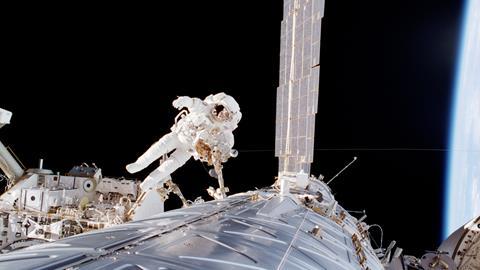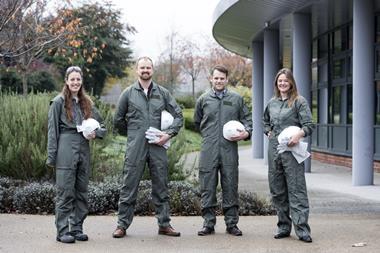Meera Senthilingam
This week a compound enabling us to go to infinity and beyond with some slippery applications here on earth as well. Explaining more, it's Brian Clegg.
Brian Clegg
Anyone with a serious interest in space exploration will know about the debates over the scientific value of manned spaceflight. Many would argue that it is very hard to justify this as an effective use of scarce finances - unmanned probes are just as capable, easier to achieve and less expensive. America did not put a man on the Moon for science, it was a political action. But there is always one fallback for those who support the expense and risk of manned missions - that the challenges of getting human beings into space drives the development of exciting new technology. Technology that then finds everyday terrestrial applications. And one of the most commonly cited examples of the space race's philanthropy is polytetrafluorethylene, or PTFE, which Nasa used extensively in the shuttles and suits that carried its astronauts into space.

Except that, in this case, the argument is founded on a myth. Polytetrafluorethylene certainly had its uses in space, but this polymer was around long before Nasa was even formed.
PTFE consists of a chain of tetrafluorethylene molecules, a simple compound analogous to ethene but with four fluorine atoms replacing the four hydrogen atoms attached to the two double bonded carbons. And instead of being developed at some Nasa research establishment, PTFE was invented - or rather discovered - in 1938 in a chemical factory in New Jersey by research chemist Roy Plunkett. He was not working on coatings or polymers, but on refrigerants.
Plunkett was using a cylinder of tetrafluorethylene gas, which appeared to run out long before all the contents should have been used up. He could have just shrugged his shoulders and got a new cylinder, but with the kind of curiosity that drives all good science and technology, he wanted to know why the gas had stopped emerging when the weight of the cylinder implied it was anything but empty. There was also some concern that if someone else tried to use the cylinder it might explode.
Outside the building, standing behind a shield erected in case of a blast, Plunkett gingerly cut through the casing and discovered a white, waxy deposit that did not stick to the inner walls of the cylinder and felt slippery to the touch. The combination of high pressure and the catalysing action of the iron cylinder had turned the gaseous molecules into a polymer. What they had was polyethylene, or polythene, with a fluorinated twist that would give it remarkable properties. The substance was patented by the DuPont subsidiary, Kinetic Chemicals, where Plunkett worked and given the trademark Teflon in 1945.
Among the first uses of PTFE was coating valves and joints to produce a good seal, a use that any plumber will tell you is still going strong. And it was in this kind of role that PTFE played its part in the second world war, when it was used to keep the seals in the pipes carrying uranium hexafluoride for the Manhattan Project secure. But the archetypal domestic use of PTFE was dreamed up by a housewife in France.

French engineer Marc Gregoire had been using PTFE on his fishing tackle, but his wife Colette felt that a more interesting use of this super-smooth substance would be to prevent food sticking to her cooking pans. Gregoire had doubts about using PTFE at high temperatures but in 1954 he devised a way to bond Teflon resin to an aluminium pan - a non-trivial task, given the material's non-stick properties. The aluminium was first etched with acid so it became pitted and then PTFE powder was heated on the surface so that it bonded to the scarred metal. Two years later his small factory in Sarcelles produced the first non-stick pan under the brand name Tefal, a word formed from Teflon and aluminium.
PTFE's effectiveness as a coating for pans is in part down to its hydrophobic nature - it naturally repels water and does not provide much for materials to cling onto, giving it a very low coefficient of friction. It isn't even susceptible to electrostatic van der Waals forces, which means that even the famously adhesive feet of geckos can't get a grip on a PTFE surface. It also has a relatively high melting point for a polymer because of the attraction between its chains, which is rather essential for cooking.

We are familiar with PTFE as the coating on cookware or sealing joints, but it comes into play in a huge range of other applications. It is found in the coating of the O2 dome at Greenwich and as a membrane on air filters. Because it is resistant even to hydrofluoric acid, which dissolves glass, it is used to keep containers for highly corrosive materials intact. It finds its way into medicine as a graft in arterial bypasses, and to coat armour piercing bullets so that their extra-hard surface doesn't damage the rifling in a gun's barrel. It has even found its way onto body-piercing jewellery to prevent infections. And although space suit technology has since moved on, a PTFE coating ensured that the fibres of Neil Armstrong's suit were safe from the abrasive lunar dust as he took that one small step.
This slippery customer is one of the most versatile of the synthetic materials that are so important in modern civilization. Even its origins seem to slip away from reality to land in the exotic world of space travel. But in down-to-Earth reality, from frying pans to navel rings, PTFE makes sure that life moves along a little more smoothly.
Meera Senthilingam
Science writer Brian Clegg there with the slippery smooth chemistry of PTFE. Next week another versatile compound that comes to our minds when we think of sport, or more specifically, the pain of overdoing a sport - but it enters our lives in more ways than we know
Jessica Gwynne
The accumulation of lactic acid may cause the burn felt in your muscles during exercise, and for a long time, it was also thought that lactic acid was responsible for the muscle ache that you feel the following day. In reality this soreness is caused by muscle damage and tissue inflammation.
The build-up of lactic acid in your muscles isn't the only way it gets into your life, however. Fermentation is another form of anaerobic respiration, and it's through this route that lactic acid produces the characteristic acidic flavour of yogurt. Lactic acid, often in the form of either sodium or potassium lactate, is also used commercially as an additive in a wide variety of foods. It is used to regulate the pH of drinks such as fruit juice and beer, and due to its antimicrobial properties but mild taste, it is commonly used as a preservative to extend the shelf life of things like meat, fish and salads.
Meera Senthilingam
And to discover the science behind these multitude of uses for lactic acid, join Jessica Gwynne in next week's Chemistry in its element. Until then, thank you for listening, I'm Meera Senthilingam.













No comments yet